Understanding when to blanket your horse is crucial for their comfort and health. Factors like coat, environment, and health determine needs. Proper blanketing ensures warmth without overloading, especially in extreme cold.
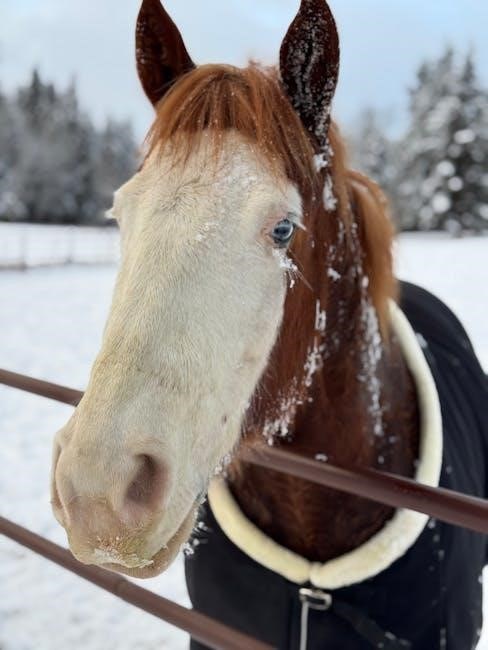
Determining Factors for Blanketing Your Horse
Your horse’s coat, living situation, age, health, and geographic location are key factors. Assessing these elements ensures proper blanketing and prevents discomfort or health risks.
Hair Coat and Its Impact on Blanketing Needs
A horse’s hair coat significantly influences blanketing decisions. In winter, a thick coat provides natural insulation, reducing the need for heavy blankets. However, clipped horses lose this protection and require more substantial blanketing to maintain warmth. The coat’s thickness and condition are vital factors; a well-maintained coat can prevent overheating when blanketed. Over-blanketing can lead to sweating and discomfort, so it’s crucial to balance protection with the horse’s natural insulation. Monitoring the horse’s response to temperature changes helps in making informed blanketing choices. This approach ensures the horse stays comfortable and healthy throughout the colder months.
Living Situation: Indoor vs. Outdoor
A horse’s living situation plays a significant role in determining blanketing needs. Indoor horses are often exposed to warmer temperatures and protection from wind and rain, which may reduce the need for heavy blanketing. Conversely, outdoor horses are more exposed to harsh weather conditions, requiring additional layers for warmth. Outdoor horses may need waterproof and breathable blankets to protect against rain and wind. Indoor settings often provide shelter, but over-blanketing can lead to overheating. Monitoring the horse’s environment and adjusting blankets accordingly is essential. Horses in stalls or barns might require lighter blankets, while those in pastures need more robust options. Balancing protection with comfort ensures the horse remains healthy and comfortable in any living situation.
Age and Health Status of the Horse
The age and health status of a horse significantly influence blanketing decisions. Younger horses, especially foals, may require additional warmth due to their developing coats and higher metabolic rates. Older horses often benefit from extra insulation, as they may lose body heat more easily and have less robust coats. Horses with health conditions, such as arthritis or respiratory issues, may need more protective blanketing to stay comfortable. Those in poor body condition or underweight should also be prioritized for blanketing. Monitoring the horse’s overall health and adjusting blankets accordingly ensures their well-being. Always consider individual needs, as some horses may be more sensitive to cold than others based on age and health. Proper blanketing supports their comfort and health throughout the colder months.
Geographic Location and Climate
Geographic location and climate play a crucial role in determining when to blanket a horse. Horses in colder, northern regions with harsh winters may require heavier blankets earlier in the season. In contrast, horses in milder climates, such as the southern United States or parts of California, may need lighter blankets or even no blanketing at all. Coastal areas with high humidity and wind chill may necessitate waterproof blankets to protect against moisture and cold. Regions with extreme temperature fluctuations may require more frequent adjustments to blanketing. Understanding the local climate and weather patterns is essential for making informed decisions about blanketing. Always consider the specific needs of your geographic area to ensure your horse stays comfortable and protected. Local knowledge can help tailor blanketing strategies to match regional weather conditions effectively.
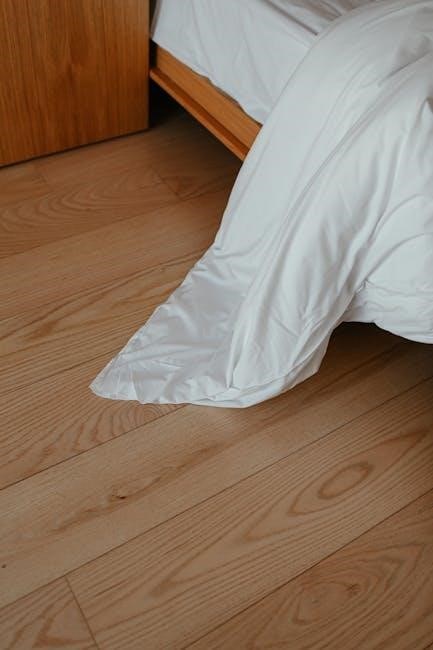
Temperature Guidelines for Blanketing
Blanketing decisions depend on temperature ranges. Lightweight blankets are suitable for 50°F-65°F, medium-weight for 30°F-50°F, and heavyweight for below 30°F. Adjust based on individual needs.
50°F ─ 65°F: Lightweight Sheet or No Blanket
Between 50°F and 65°F, horses may not need heavy blanketing. Their natural coat often suffices, but a lightweight sheet can provide extra protection from wind or rain. Consider the horse’s activity level, living conditions, and individual comfort. Active or healthy horses might not need a blanket, while older or sensitive horses might benefit from a lightweight option. Monitor for signs of discomfort or overheating, adjusting as needed. Ensure proper nutrition and a clean, well-ventilated living environment to support their natural warmth. Observation and flexibility are key to maintaining comfort and health in this temperature range.
40°F ⸺ 50°F: Lightweight Blanket or Sheet
At temperatures between 40°F and 50°F, a lightweight blanket or sheet is typically appropriate for most horses. This range often requires minimal coverage to protect against chill, especially for horses with a natural winter coat. Consider the horse’s age, health, and living conditions. Older or thinner horses may need more protection, while younger, healthy horses might manage with less. If the horse is clipped or has limited natural insulation, a lightweight blanket is essential. Ensure the blanket fits properly and monitor for signs of discomfort or overheating. Adjustments may be necessary based on individual needs and weather fluctuations. Proper care and observation are key to maintaining comfort in this temperature zone.
30°F ─ 40°F: Medium-Weight Blanket
When temperatures drop between 30°F and 40°F, a medium-weight blanket is ideal for most horses. This range requires more insulation than lighter options but not the heaviest blankets; Horses with a natural winter coat may still need protection, especially if they are exposed to wind or moisture. Medium-weight blankets provide adequate warmth without risking overheating; Consider the horse’s individual needs, such as age, health, and living conditions. Clipped or thinner horses may benefit from this weight to stay comfortable. Ensure the blanket fits properly and allows for movement. Monitoring the horse’s behavior and adjusting the blanket as needed is crucial. This range is a transitional period, so flexibility in blanketing is key to maintaining comfort and preventing chilling.
Below 30°F: Heavyweight Blanket
For temperatures below 30°F, a heavyweight blanket is essential to protect your horse from extreme cold; This range poses a higher risk of hypothermia, especially for clipped or senior horses. Heavyweight blankets are designed to provide maximum insulation and are typically filled with high-loft materials; They are ideal for horses living outdoors without access to shelter or for those exposed to harsh winds. Ensure the blanket is waterproof to prevent moisture from penetrating and chilling the horse. Monitor your horse’s comfort, as overheating can occur if the blanket is too heavy for their needs. Adjustments may be necessary, especially during fluctuating temperatures. Proper fitting is crucial to avoid restricting movement and ensure the horse remains warm and comfortable in freezing conditions.
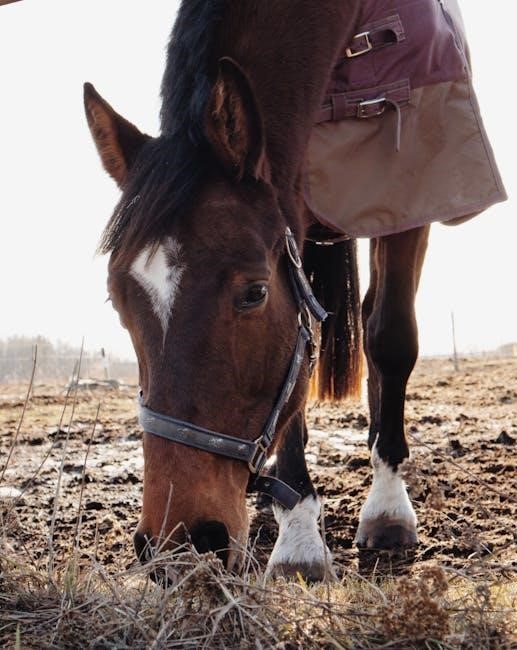
How to Choose the Right Blanket
Selecting the right blanket involves assessing your horse’s specific needs, including their coat type, climate, and living conditions. Consider weight, fit, and material to ensure comfort and durability.
Understanding Blanket Weights and Fill Powers
Blanket weights are categorized as lightweight, medium-weight, or heavyweight, each designed for specific temperature ranges. Lightweight blankets (0–150g fill) are suitable for mild weather (50°F–65°F), while medium-weight (150–300g fill) and heavyweight (300+g fill) blankets are for colder conditions. Fill power measures insulation quality, with higher fill power indicating greater warmth retention. Understanding these factors helps match the blanket to your horse’s needs, ensuring comfort without overheating. Climate, coat type, and individual tolerance also influence the choice. Proper selection prevents chilling or sweating, maintaining your horse’s health and well-being during colder months. Always consider your horse’s unique requirements when choosing blanket weight and fill power for optimal comfort and protection.
Measuring Your Horse for the Correct Size
Proper fit is crucial for your horse’s comfort and safety. To measure your horse, start by standing them on a level surface and measuring from the center of their chest to the edge of their hindquarters. This ensures the blanket will cover their body evenly. Use a flexible tape measure and take note of the length in inches or centimeters. Ensure the blanket allows for natural movement and doesn’t restrict the shoulders or hind legs; Check the fit on both sides to confirm symmetry. A well-fitted blanket prevents rubbing and ensures proper coverage. Always refer to the manufacturer’s size chart and adjust based on your horse’s individual build and posture for the best fit.
Material and Waterproofing Considerations
Horse blankets are made from various materials, each offering unique benefits. Nylon is durable and ideal for outdoor use, while polyester provides a lightweight and breathable option. Waterproofing is essential to protect your horse from rain and snow, but it’s crucial to balance waterproofing with breathability to prevent overheating. Look for blankets with waterproof coatings or treatments that maintain airflow. Regular cleaning and proper storage can extend the life of the waterproof material. Consider your horse’s climate and living conditions when choosing the material—durable, waterproof options are best for wet environments, while lighter fabrics suit drier climates. Always follow manufacturer care instructions to preserve the blanket’s performance and ensure your horse stays comfortable and dry.

Maintenance and Safety Tips
Regularly inspect blankets for tears or wear to ensure safety and functionality. Clean them periodically to prevent skin irritation. Always ensure proper fit to avoid rubbing or injury.
Regular Inspection and Cleaning of Blankets
Regularly inspect horse blankets for signs of wear, such as tears, frayed edges, or broken buckles, to ensure they remain safe and functional. Cleaning blankets is essential to prevent dirt buildup, which can cause skin irritation or infections. Brush your horse thoroughly before blanketing to remove loose hair and dirt. Use mild detergents specifically designed for equine gear, avoiding harsh chemicals that could damage materials or harm your horse. Allow blankets to air dry completely after washing to prevent mildew. Store clean, dry blankets in a well-ventilated area during the off-season. Regular maintenance extends the lifespan of blankets and ensures your horse stays comfortable and protected. Always check for proper fit to avoid rubbing or injury.

Ensuring Proper Fit to Prevent Rubbing or Injury

Ensuring a proper fit is crucial to prevent rubbing or injury when blanketing your horse. A poorly fitted blanket can cause discomfort, skin irritation, or even injury. Always measure your horse accurately to select the correct size. The blanket should fit snugly but allow for natural movement, with adequate coverage over the shoulders and hindquarters. Check that the neck opening is not too tight or restrictive, as this can impede breathing or movement. Buckles and straps should be adjusted to prevent pressure points. Avoid using blankets with worn-out or sharp hardware, as these can cause rubbing. Regularly inspect the fit, especially as your horse’s size or condition changes, and adjust accordingly. A well-fitting blanket ensures comfort and safety for your horse.

Special Considerations
Special considerations include horses with medical conditions, senior horses, or those with specific needs like Cushing’s or arthritis. Climate, humidity, and wind chill also play roles.
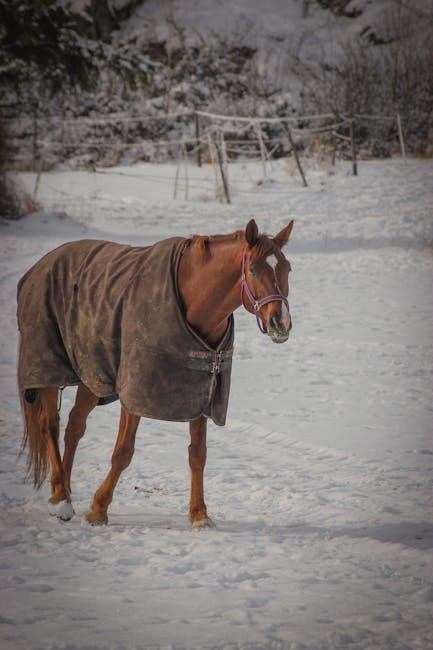
Blanketing Unclipped Horses with a Full Winter Coat
Unclipped horses with a full winter coat typically have natural insulation, reducing the need for heavy blanketing. However, extreme cold, wind, or wet conditions may require additional protection. A lightweight blanket can provide extra warmth without overwhelming the horse. It’s essential to monitor the horse’s comfort and adjust blanketing based on individual needs. Over-blanketing can lead to sweating, which defeats the purpose of the coat’s natural insulation. For temperatures below 30°F, a medium-weight blanket may be necessary, but always ensure proper fit and breathability. Horses living outdoors or in harsh climates may benefit from waterproof blankets to shield against rain or snow. Ultimately, observe your horse’s behavior and physical condition to determine the right blanketing strategy.
Blanketing Clipped or Body-Clipped Horses
Clipped or body-clipped horses require careful blanketing due to their reduced natural insulation. These horses lose their ability to regulate body temperature effectively, making them more sensitive to cold. Lightweight blankets are often necessary even in milder temperatures, such as 40°F to 50°F, to prevent chilling. As temperatures drop below 30°F, heavier blankets may be required to maintain warmth. Proper fit is crucial to avoid discomfort or injury. Regular monitoring of the horse’s condition is essential, especially during extreme cold snaps, to ensure they are not too hot or cold. Expert recommendations suggest blanketing clipped horses whenever temperatures fall below 40°F to prevent chilling. Always ensure the blanket fits well and adjust based on the horse’s individual needs and environmental conditions.
Layering Blankets for Extreme Cold
Layering blankets is an effective strategy for protecting horses in extreme cold. Start with a lightweight base layer to wick moisture, followed by a medium-weight blanket for insulation, and finish with a heavy-duty, waterproof outer layer. This system allows you to adjust the horse’s coverage based on changing temperatures. For example, in temperatures below 20°F, adding a fleece or thermal liner under a heavyweight blanket can provide extra warmth. Always ensure the outer blanket is breathable and waterproof to prevent chilling from moisture. Monitor your horse’s comfort and adjust layers as needed to avoid overheating, which can lead to sweating and discomfort. Proper layering ensures your horse stays warm and comfortable in harsh winter conditions.
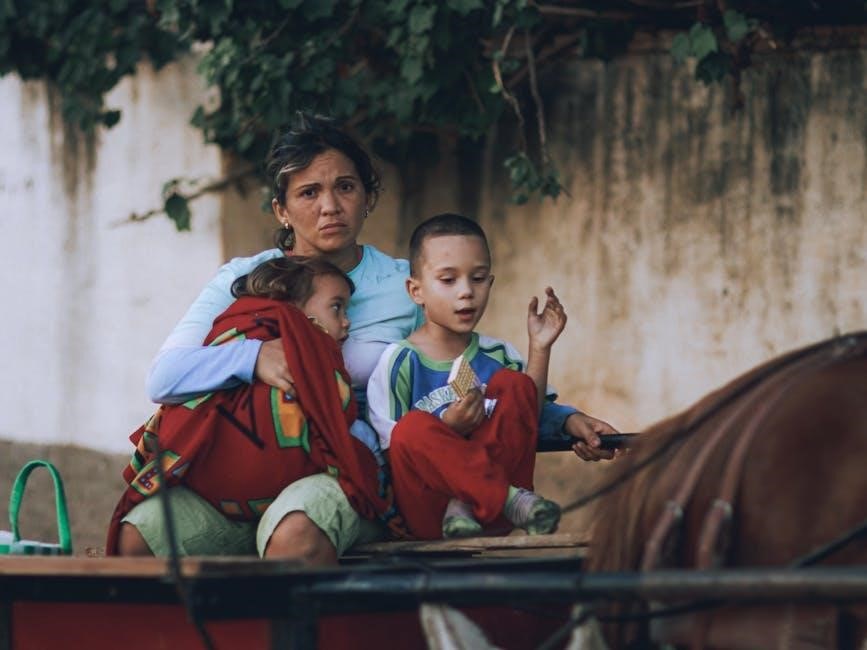
Best Practices for Blanketing
Monitor weather conditions, adjust blankets as needed, and check your horse daily to ensure comfort and prevent overheating or chilling. Tailor blanketing to individual needs.
Monitoring Weather Conditions and Adjusting Blankets
Always monitor local weather forecasts to determine if blanket adjustments are necessary. Pay attention to temperature fluctuations, wind chill, and precipitation, as these factors significantly impact a horse’s comfort. For example, a horse may need a heavier blanket in cold, windy conditions or a waterproof layer during rain or snow. Horses living outdoors often require closer monitoring, as they are more exposed to elements. Adjust blankets daily to ensure they are appropriate for current conditions, and consider the horse’s individual needs, such as age, health, and coat type. Regular checks help prevent overheating or chilling, ensuring the horse remains comfortable and healthy year-round. Use weather apps or local reports to stay informed and make timely adjustments.
Removing and Resetting Blankets Daily
Removing and resetting your horse’s blanket daily is essential to ensure their comfort and prevent potential health issues. Check for signs of overheating, such as sweating or restlessness, and remove the blanket if necessary. This is especially important in fluctuating temperatures or during physical activity. Inspect the blanket for dirt, moisture, or damage, and clean or repair it as needed. Resetting the blanket ensures proper fit and prevents rubbing or shifting, which can cause discomfort or injury. This daily routine also allows you to assess your horse’s coat condition and adjust blanketing accordingly. Regular checks help maintain your horse’s well-being and extend the life of the blanket. Make it a habit to inspect and adjust blankets morning and evening to ensure your horse remains comfortable and healthy. This practice is crucial for understanding your horse’s specific needs and preferences. By doing so, you can provide optimal care tailored to their requirements.
Considering Individual Horse Needs and Preferences
Every horse is unique, and their blanketing needs can vary based on age, health, and personal comfort levels. For example, older horses or those with medical conditions may require more insulation, while younger, healthier horses might tolerate cooler temperatures. Horses with a full winter coat may need less blanketing than clipped horses. Additionally, some horses are naturally more sensitive to cold, while others prefer minimal coverage. Observing your horse’s behavior and physical condition is crucial. Look for signs of discomfort, such as shivering or sweating, to gauge if their blanket is too heavy or too light. Proper fit is also essential to prevent rubbing or restriction of movement. By tailoring your approach to your horse’s specific needs and preferences, you can ensure their comfort and well-being during colder months. This personalized care helps maintain their health and happiness year-round.
